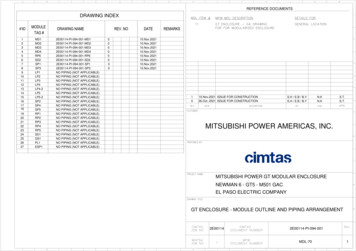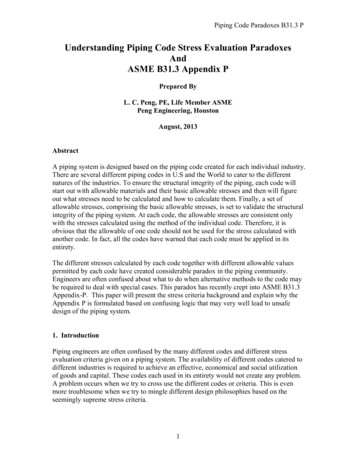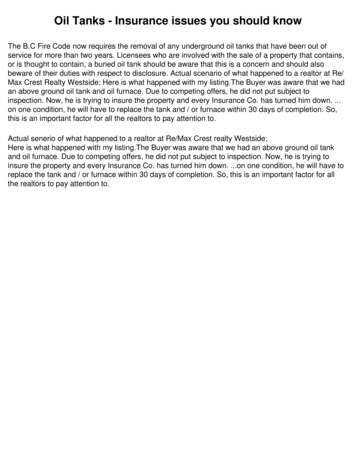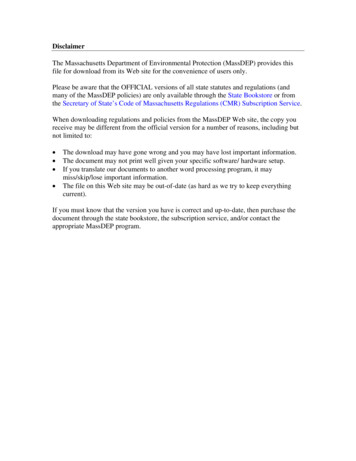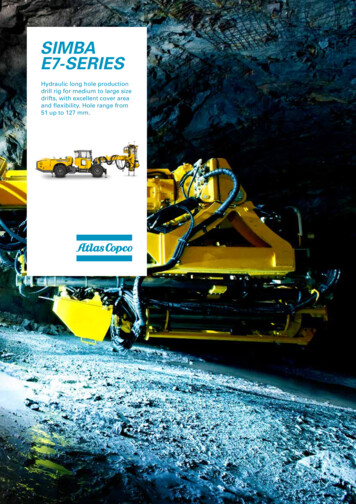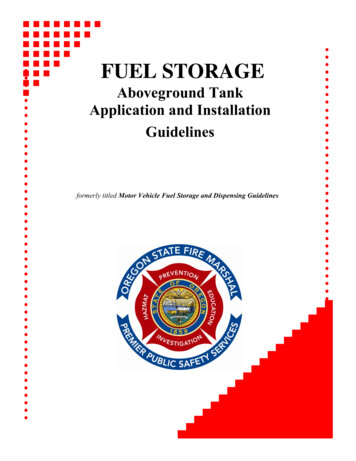
Transcription
Chapter 3Oil Tanks and PipingChapter 3Oil Tanks and PipingIntroductionThe comfort, cleanliness and efficiencyof today’s oilheat systems rely on clean,uncontaminated fuel reaching the oilburner.To achieve this: Install tanks properly. Maintain tanks by regularly inspectingthem and fixing minor defects beforethey lead to major problems. Replace aging tanks before they fail.The proper installation of an oil tank is arelatively easy process, provided it isinstalled in accordance with themanufacturer’s instructions and applicablecodes and regulations are followed.Local codes normally require you toinstall tanks in accordance with either theirown code, the National Fire ProtectionAssociation (NFPA) or the InternationalCode Council (ICC). It’s best to check withthe local authority having jurisdiction todetermine which regulations you need tofollow.This chapter gives an overview of oiltanks; for more detailed information, werecommend that you read NORA’s oil tankmanual, “Heating Oil Storage Tanks, Guidefor Quality Installation and Maintenance.”Why tanks failThe most common cause of failure iscorrosion—the deterioration of the tankdue to reaction with its environment.External corrosion is caused byelectrical activity that occurs betweendifferent parts of the tank; between the tankand its piping; or between the tank andother metals in the area. For externalcorrosion to occur, there needs to be:1. an anode— something to give upelectrons (the tank);2. a cathode— something to accept theelectrical flow (piping, metals in theground, etc.);3. an electrolyte— something for theelectricity to travel through (water).There is not much you can do to preventexternal corrosion in existing unprotectedunderground (buried) tanks. Later in thischapter, we’ll show the types of tanks thatcan stand up to the corrosion factors thatexist underground.To reduce exterior corrosion for aboveground tanks, make sure that: The tank has clearance on all sides sothat debris can’t accumulate and holdmoisture against the tank. There is sufficient clearance under thetank so that plant growth does notcome in contact with it. Scratches and rust are repairedimmediately. The tank is painted on a regular basis.Internal corrosion is caused by sludgeproduced by bacteria. For internal corro-Chapter 3—Oil Tanks and Piping3-3
Chapter 3Oil Tanks and Pipingsion, Figure 3-2, is to eliminate the waterat the bottom of the tank. Removing thewater is just the beginning. You must alsodetermine how the water got into the tankand take corrective steps to prevent waterfrom building up again. Figure 3-3.Figure 3-1: Variouslayers of materialin the tanksion to occur at the tank bottom, thereneeds to be bacteria and water in the tank,see Figure 3-1.The bacteria live at the oil/waterinterface; they “eat” the oil and create asubstance that, when mixed with water,creates an acid that corrodes the metal inthe tank.The best way to reduce internal corro-Figure 3-2:Internalcorrosionwith pin holemagnifiedFigure 3-3: Bacterial “Bug Tracks”The most common causes of waterin tanks are: Condensation Broken tank gauges (outside tank) Loose or missing fill and vent caps Pumping oil from an old tank into anew tank Failing to drain water from a tankbefore installation.Condensation can be greatly reduced byinstalling tanks indoors or in an enclosure.If a tank is located outside, you can reducecondensation by painting it a light colorand protecting it from direct sunlight.Gauges and caps should be inspectedregularly and replaced when necessary.3-4Oil Tanks and Piping
Chapter 3Oil Tanks and PipingFollowing manufacturer’s instructionswhen installing new tanks and performingthe inspection procedures described at theend of this Chapter, you will greatly reducethe amount of water-related problems andextend the lives of your customers’ tanks.Properly installed and maintained tankscan last for several decades—much longerthan most equipment in the home. However, like everything else, tanks eventuallyneed to be replaced.Installation considerationsWhen it is time to install a new orreplacement tank—answer these threequestions: What size tank will be best? Where is the best place to install it? What type of tank will be best?SizeAlthough large tanks are often installedfor delivery efficiency, an oversized tankcan cause service problems—such as: Poor fuel quality—fuel oil has a shelflife and deteriorates over time. Corrosion—larger tanks usually buildup more water from condensation.On the other hand, tanks that are toosmall require frequent deliveries, leading toproblems during peak delivery season.In general, the right size tank is one thatholds about one-third (1/3) of thecustomer’s annual consumption. Therefore,a customer who uses 900 gallons of oil ayear should have a 275 or 330-gallon tank.(900/3 300)There may be special situations thatrequire you to install a tank that is eitherlarger or smaller, but in general, it is bestto apply the 1/3 rule when possible.LocationThere are three possible locations for atank installation:1. Inside a building—usually in thebasement, utility room or garage2. Outside, above–ground3. Outside, undergroundBefore selecting a tank location, be sureto consider regulations regardingsetbacks from: Heating equipment and otherignition sources Property lines Buildings, doors, windows, vents andair intakes MetersAlso remember to locate the tank where: The delivery vehicle can safely parkduring filling It will be accessible for inspectionand servicing An oil release will not easily enter adrain, well or waterway It will not be exposed to corrosionand/or damage from dripping water,falling ice, vehicles, etc.Inside tanksNORA recommends above ground,indoor tank installations whenever possible.These installations offer a number ofadvantages over outside tanks, including: The oil is usually warmer, whichmeans it burns better and won’t gel orhave cold weather performanceproblems.Chapter 3—Oil Tanks and Piping3-5
Chapter 3Oil Tanks and Piping There are fewer temperature changes,which means the oil will last longer. If a leak develops, it will cause anodor, which quickly alerts us to theproblem. It’s easier to inspect. Less condensation in the tank.It is important that you follow codes andinstructions regarding:A. Distance from the tank to the burner(At least 5 feet.)B. Size and height of the vent pipe2. All tanks should have a vent alarm3. All tanks should have a tank gauge4. All systems should have an oil filter;it can be located at the tank, at the burneror at both the tank and burner.5. The copper oil line from the tank tothe burner (shown here running under thefloor) should not touch concrete or soil.This can be done by sliding the copper oillines into plastic conduit or plastic pipe orby using a coated copper line.There should be no fittings in the copperlines below the floor. Figure 3-4.C. Size of the fill pipeD. Fusible valve at the tankE. Fusible valve at the burnerIn addition:Figure 3-4:Typical indoorinstallation1. The fill and vent lines must bepitched toward the tankAbove-groundoutside tanksIf there is no room for a tank inside thebuilding, it must be installed outside, seeFigure 3-5. In these cases, it is a good ideato install the tank in secondary containmentCoated Copper Line3-6Oil Tanks and Piping
Chapter 3Oil Tanks and Pipingthermal shut-off valve.The oil filter shouldNOT be installedoutside. It can beinstalled right after thevalve where the lineenters the building orat the burner.UndergroundtanksFigure 3-5: Outside above ground tankor in an enclosure to protect it from theelements.The outside oil line should be connectedthrough the top of the tank and insulated towhere it enters the building. Once the lineis inside, it should be connected to aEnvironmentalregulations andinsurance concernshave greatly reducedthe number of inground installations,Figure 3-6, and many homeowners withburied oil tanks have replaced them withabove-ground tanks.Unless there is no acceptable locationavailable, NORA recommends that all newoil tanks be installed above ground.Figure 3-6:Typical olderundergroundinstallationVent Line1 ¼" Minimum2" Fill PipeAnti-Siphonor BallCheck ValveInspectionPortSwing JointTeeSwingJoint½" Copper TubingFuel Storage TankValveOil FilterLoop Oil LinesChapter 3—Oil Tanks and Piping3-7
Chapter 3Oil Tanks and PipingTypeOnce you have determined the propersize and location to install a new tank, yourcustomer can choose the type of tank basedon price, warranty and level of spillprotection. There are many choices:Figure 3-7:Ob-roundtankAbove groundtanksOb-round—The 275gallon “Ob-round” steeltank, Figure 3-7, has beenthe standard for decadesand is the most commontank. Ob-round tanks arecurrently available in anumber of sizes fromslightly over 100 gallons to330 gallons.Figure 3-9:Externallycoated tankExternally coated ob-round—Thiscorrosion resistant tank has a polyethylenecoating on the outside of a standard obround tank, Figure 3-9. The coatingprotects the tank from external corrosionand serves as release barrier should thetank corrode internally.Fiberglass—This corrosion proof tankis available in both single and double wallmodels and in 240 and 300-gallon capacities. The double wall unit is a tank within atank— if the inner tank leaks, the outertank prevents a release of oil, Figure 3-10.Figure 3-8:Bottom tapNewer ob-round tanks have the oildrawn from the bottom of the tank toreduce the amount of condensation andsludge build-up in the tank. Figure 3-8.Cylindrical—These tanks are oftenfound in mobile homes and in places wherespace considerations made it easier toinstall and service than an ob-round tank.They are typically available in sizesranging from 160 to 320 gallons.3-8Oil Tanks and PipingFigure 3-10: Fiberglass tank
Chapter 3Oil Tanks and PipingPolyethylene/steel – These double walltanks combine an inner tank made ofpolyethylene with a steel outer tank. Theouter tank protects the inner tank andprovides secondary containment. SeeFigure 3-11.2. Sacrificial anodes that protect the steel3. Nylon isolation bushings that electrically isolate the tank from the fill pipe, ventpipe, oil lines and other attached pipingACT-100 and ACT-100UThese tanks include a much thickerprotective coating and offer protectionsimilar to the Sti-P3 without sacrificialanodes, Figure 3-13.Figure 3-11: Polyethylene/steel tankUnderground tanksFigure 3-13: ACT-100SteelSti-P3—These tanks combine thestrength of steel with a factory installedcorrosion protection system, Figure 3-12.Sti-P3 tanks feature:Fiberglass (FRP)Fiberglass reinforced plastic tanks neverrust because they are made from corrosionresistant materials, Figure 3-14.1. A protective coating over the steelthat prevents external corrosionOnce you’ve determined the right size,location and type of tank to install, youFigure 3-12: Underground steel tankFigure 3-14: Fiberglass (FRP) tankChapter 3—Oil Tanks and Piping3-9
Chapter 3Oil Tanks and Pipingmust become thoroughlyfamiliar with the currentversion of the manufacturer’sinstallation instructions beforeyou begin an installation.InstallationproceduresBe sure to follow themanufacturer’s installationinstructions and all applicablecodes and regulations duringFigure 3-15: Above ground vent pipe/fill and vent capthe installation. Thisnext section emphasizessome of the importantflue gas outlet. All steel fittings should besteps in tank installation process.malleable, not cast.Work neatThe fill pipe should be clearly marked asProtect the customer’s propertya fuel oil fill. The vent cap should have aand the components that you arescreen to prevent bugs from making a nestinstalling. It is much easier toin the vent pipe, Figure 3-15.prevent a mess than to clean it up.Cover work areas with drop cloths orbuilder’s paper or other material,Vent alarmsFigure 3-14.All aboveground andindoor tanksPiping connectionsshould have aIt is imperative that all connections arevent alarmmade tight and leak proof. All threadedinstalled, Figureconnections should be joined with a pipe3-16. The ventcompound that is non-teflon, oil resistant,alarm alerts theand remains flexible. Be careful whendelivery personapplying pipe compound and make sure tothat the tank iswipe away excess compound so it does notget into the tank or oil lines.filled to theproper level. Ventalarms are notFill and vent pipesFigure 3-16:always requiredVent alarmThe fill and vent pipes should be madefor residentialof schedule 40 steel, be pitched toward theburied tanks because a special filling devicetank and terminate outside the building at a(vent-a fils, bazooka, deep fill, etc.) thatpoint at least two feet from any buildingopening, and five feet from any air inlet orincludes a vent alarm may be used.Figure 3-14:Cover workareas3-10Oil Tanks and Piping
Chapter 3Oil Tanks and PipingOil linesPlug or capFor normal residential use, 1/2" O.D. oillines are recommended. Copper oil linesshould be connected with flare fittings.Compression fittings must not be used(“slip fittings”, where the oil line enters thetop of the tank, are the exception and areacceptable).Plastic ormetal plugsare used tokeep waterand debrisout of a newtank duringshipment andstorage. Theymust beremoved anddiscardedduringinstallation and any unused tank openingsmust be plugged with threaded steel plugs.Oil lines should have as few fittings aspossible and all fittings should be accessible.Thermal shutoff valvesIndoor tanks should have a thermalsafety shutoff (Firomatic ) valve in thesuction line at the tank, see Figure 3-17.Outside tanks should have a shut off valvewhere the suction line enters the inside ofthe building.FiltersAn oil filter should be installed in thesuction line. See Figure 3-18.Figure 3-17: Thermal safety shutoff valveFigure 3-18:Oil filter installedin suction lineTank inspectionproceduresOil tanks should be inspected on aregular basis so that potential problems canbe discovered and corrected before theyaffect tank longevity and system performance.NORA recommends three levels ofinspection—an initial inspection performedbefore a delivery is made to a new tank ora new customer; a routine inspectionperformed during routine maintenance ortune-ups; and brief, pre-delivery inspectioneach time the tank is filled.1.) Initial inspections and evaluationsNORA recommends that all tanks shouldbe inspected and approved for deliverybefore the first delivery to a new customeror a new tank.An initial inspection provides theopportunity to notice flaws in the tank, notreported by the customer, which mayChapter 3—Oil Tanks and Piping3-11
Chapter 3Oil Tanks and Pipingprevent a problem in the future. It will alsoensure that the fill and vent pipes areproperly connected and correctly identified.In those cases where a new tank has beeninstalled for an existing customer, the tankinspection should include procedures toensure that inactive fill and vent pipes havebeen removed.Figure 3-19:Inspection ofabove ground tankThe inspections are different for aboveground tanks and buried tanks.2.) Routine inspectionsNORA recommends that additional tankinspections be conducted as anintegral part of preventativemaintenance tune-ups.While not as comprehensive as the initial inspection,routine inspections areequally important.Routine inspectionscan detect problems thatoccur after the tank haspassed the initial3-12Oil Tanks and Pipinginspection. For example, the tank gaugemay have become defective, a tank leg maystart to corrode, or another problem mayhave arisen long after the tank was initiallyapproved for delivery.In many situations, routine inspectionsdetect minor problems that have recentlystarted and that can be easily correctedbefore they cause a problem.3.) Brief, pre-delivery inspectionNORA recommends a “no-whistle-nofill policy.”Oil delivery personnel should perform abrief visual inspection before and aftereach delivery. While this inspectionnormally isn’t documented, it’s importantthat fuel drivers understand the need toverify addresses and check tanks forobvious defects before and after delivery.The step-by-step inspection procedures forabove ground and underground tanks are on thefollowing pages.
Chapter 3—Oil Tanks and Piping00
falling ice, vehicles, etc. Inside tanks NORA recommends above ground, indoor tank installations whenever possible. These installations offer a number of advantages over outside tanks, including: The oil is usually warmer, which means it burns better and won't gel or have cold weather performance problems. Chapter 3 Oil Tanks and Piping

